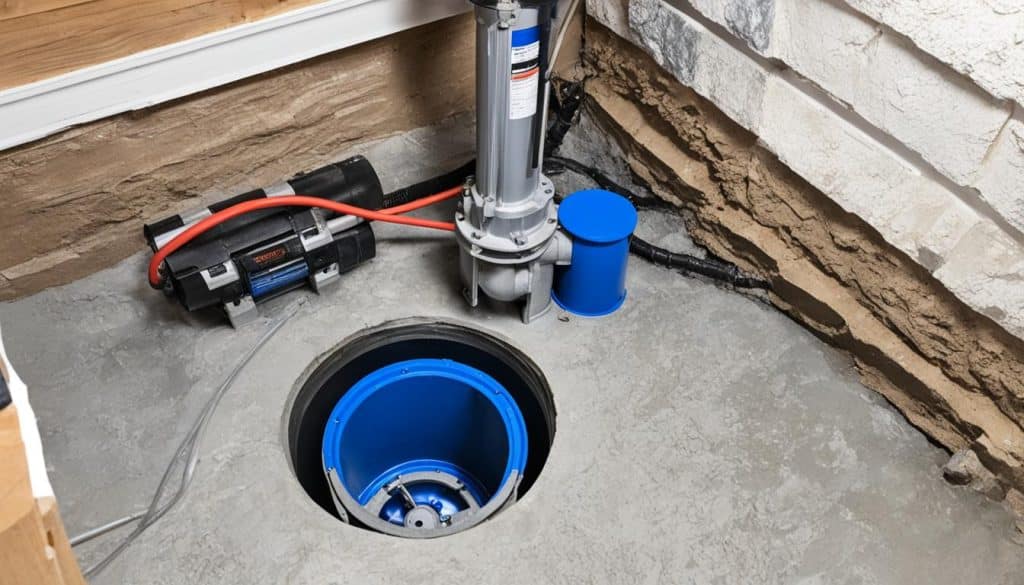Is your basement safe from flooding? How Do I Test my Sump Pump to Ensure It is Working? Testing your sump pump regularly, especially in wet seasons, is crucial. This device protects your home from water damage.
To test your sump pump, follow a few simple steps. These include power cycling and simulating water buildup. Knowing your sump pump works when needed gives you peace of mind. Let’s explore how to do these tests to keep your basement dry.
Key Takeaways
- Regularly test your sump pump during wet seasons to prevent water damage.
- Unplugging and replugging the pump helps check motor functionality.
- Simulating water buildup ensures your pump activates correctly.
- Consult the equipment’s owner’s manual for specific testing instructions.
- Increasing the frequency of testing for older pumps or those dealing with dirty water is advisable.
- A properly functioning pump will effectively remove water from the pit when activated.
Importance of Testing Your Sump Pump
Sump pumps are key to keeping your home safe from water damage. They help protect your home’s structure. Testing your sump pump regularly makes sure it works when you need it most, like during storms.
Experts say you should test your sump pump at least twice a year. This is especially important before spring and fall, when it rains a lot. This way, you keep your sump pump running well for about ten years, and it stays free from dirt and debris.
To keep your basement dry, check your sump pump often. This simple step can save you a lot of money and trouble later. Make checking and maintaining your sump pump a regular part of taking care of your home.
Steps to Test Sump Pump Functionality
It’s important to make sure your sump pump works right to avoid basement flooding. Here are the steps to test your sump pump and check if it’s working well.
Pre-Test Preparations
First, find the exit pipe outside your house and make sure it’s clear. Inside, clean up any mess around the sump pump. This helps the test go smoothly.

Testing Method: Power Cycling
Look for the two electrical cords of your sump pump. Unplug both, then plug in the pump cord alone. If you hear a humming sound, the motor is good to go. This first check is key to making sure the pump works before the water test.
Testing Method: Water Testing
To really check it out, slowly pour about 20 liters of water into the sump pit. Watch as the water level goes up and turns on the pump’s float switch. The pump should start pumping out the water well. It should also turn off by itself once the water is gone.
If your sump pump has only one cord, you’ll need to lift the float to start it. But don’t run the pump without water for too long, as it can damage the motor. This test makes sure your sump pump is ready for the next big rain.
Troubleshooting Common Sump Pump Issues
Keeping your sump pump in good shape means fixing common problems fast. This way, your pump works well and keeps your home safe from water damage.
Inspecting for Debris
Start by checking the pump and its area for any blockages. Debris in the pipes can slow down the pump. Cleaning it regularly keeps it running smoothly.
Dealing with Non-Responsive Pumps
If your sump pump doesn’t work when you test it, try resetting it. Unplug both the pump and the float cords, then wait a bit. Plug in just the pump cord. If it still doesn’t work, you might need a new one.
Ensuring Backup Power Sources
Power outages can stop your sump pump from working, especially in bad weather. Using backup power, like batteries or water systems, keeps it running. This is a key part of keeping your home safe from water damage.

Sump Pump Maintenance Tips
Keeping your sump pump in good shape is key. It helps your system last longer and work better. A regular maintenance routine can avoid sudden breakdowns and expensive fixes.
Regular Testing Schedule
Make sure to test your sump pump regularly. Check it every month, especially before the rainy season starts. This helps catch small problems early, before they get big.
Cleaning and Inspection
It’s important to keep your sump pump clean. Check the pump and pipes for blockages every few months. Make sure the inlet screen is clear to keep everything running smoothly. This stops blockages that can cause the pump to fail during heavy rain.
Professional Maintenance Services
For a thorough check-up, get help from professionals. Companies like J Sewer & Drain Plumbing Inc. in Chicago, IL, offer detailed inspections. They also provide reliable services with a 5-year guarantee on underground repairs and a 1-year guarantee on above-ground work. Professional care can make your sump pump last longer, saving you from unexpected troubles.
Conclusion
Testing and maintaining your sump pump is key to a dry, safe basement. This guide has shown how important it is to check your sump pump often. Regular checks can stop water damage before it starts.
Keeping your sump pump in good shape is more than just occasional checks. A regular testing schedule and keeping it clean are essential. If you’re unsure or need help, call J Sewer & Drain Plumbing Inc. at (773) 968-2704 for expert advice.
By regularly checking your sump pump, you protect your home and feel secure during heavy rains. Make sump pump testing a regular part of your home care routine.


